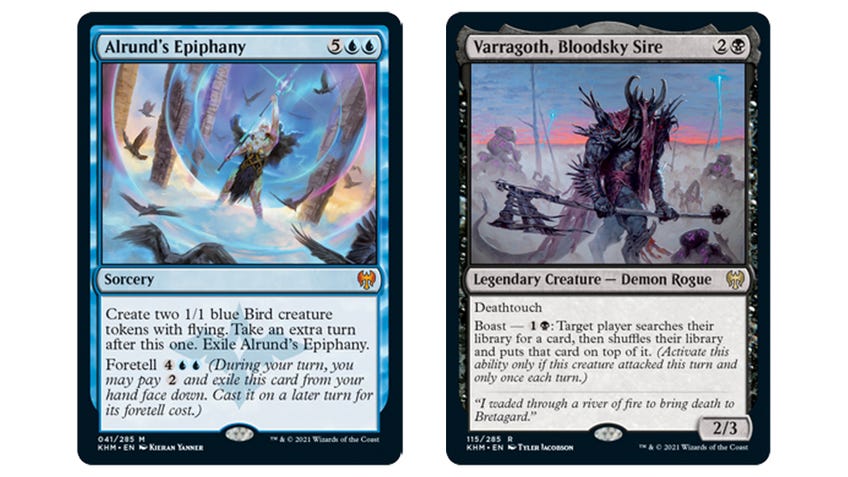Kaldheim is another excellent Magic: The Gathering set that’s caused more chaos for the card game as a whole
Trickery to untangle.
Kaldheim is here, and it’s an immensely enjoyable Magic: The Gathering set. There’s something magnificent about the sets where Wizards of the Coast goes really hard on incorporating a new bunch of our own myths into its fantasy multiverse; Kaldheim with its Norse inspirations is no different. There’s a simple joy to spotting the strange versions of characters you know and love in a different form, with the added bonus of trying to build a deck around them. If this were an article solely about the lore of this set and the flavour of the setting, then it’d be a short and incredibly glowing one.
Kaldheim is a lot more than just its inspirations, though, and the set itself is a mixed bag. There’s a lot to dive into here because while the set definitely feels good and fairly balanced overall, it does raise some important questions about interactions going forwards, along with whether or not MTG is going to be able to go a few months without some monumental upheaval, including the upcoming ban of Uro. I can’t recall a time where Wizards announced a ban ahead of time, and this one has been a long time coming.
Starting with the good, aside from two cards we’re going to get into later on, Kaldheim is a pretty well-balanced set. While you’ve no doubt seen that there are some very powerful cards around, with the likes of Goldspan Dragon and Koma, Cosmos Serpent helping to bolster some new Standard decks, most of them aren’t blatantly absurd, and it actually feels like every colour got a few really intriguing cards.
Let’s start with the mechanics on the cards. Kaldheim sees more Modal Double-Faced Cards (MDFC) enter into the world of MTG. The majority of these this time around are the God cards, who can be either a god or anything from a horn, to a boat, to a tricksy planeswalker. I really like this mechanic, and it makes for some especially fun interactions when you’ve got multiple copies of a legendary card in your hand, as well as some truly great commanders.

The new keywords are Boast and Foretell. Boast is a neat way of giving a card a combat-based ability. While it feels a little underpowered in places, the general concept is an interesting one. In essence, Boast gives creatures an ability they can activate once a turn as long as they’ve attacked. It tends to be the kind of thing you’d normally find on a spell, and it makes the creatures a little more versatile, especially if you can utilise it a couple of times. This is an ability most likely to see play in formats where you can make your creatures unblockable and protect them, which means it’s big for Commander, but probably won’t see much use elsewhere.
Foretell, on the other hand, seems like the kind of thing that could leave a lasting impact. For two mana, it allows you to exile a card from your hand facedown. You can then cast it on a different turn, often for less mana. It feels a little odd to pay the mana cost of your cards in two instalments, but it does allow for some fascinating lines of play. For example, a control deck utilising Foretell can cast spells for cheaper as long as the player invests early on. It also means they can keep cards safe that might otherwise be messed up by hand disruption like being made to discard a card. It acts as a second hand, but one that’s unlimited in size. This is basically a control player’s dream scenario, and I think we could see a few cards with this ability breaking into older formats.
Kaldheim also sees the return of snow cards. Not only snow lands, which we desperately needed more of anyway, but also other snow cards, including instants. It’s a very thematic mechanic, and having more snow lands in rotation can only be a good thing for the price of the older versions of these lands.
The cards themselves are generally pretty wonderful. I already talked about my picks for the most powerful cards in Kaldheim, and I stand by all of them as being excellent choices for anyone looking into what cards to aim for. Our spoiler card, Fynn, the Fangbearer, is a great example of some of the more subtly absurd cards - you just have to put the work in when building the deck itself, and suddenly you can recreate Infect in Standard.

However, all is not well in this set for two reasons, both of which involve the trickster of the MTG universe: Tibalt.
If you’ve been a fan of Magic: The Gathering for a while, you’ll know that Tibalt started life out as one of the most objectively terrible planeswalker cards in existence. I’m not talking unplayable either; I’m talking “content creators would make meme decks around him” bad. He had a small bounceback thanks to an interesting ability in his War of the Spark card, but was hardly a big threat. Well, my half-devil man has decided he’d had enough of the jokes, and he’s returned with a vengeance.
The first of these two cards is Tibalt’s Trickery. This is a two-mana Red instant that reads: “Counter target spell. Choose 1, 2, or 3 at random. Its controller mills that many cards, then exiles cards from the top of their library until they exile a nonland card with a different name than that spell. They may cast that card without paying its mana cost. Then they put the exiled cards on the bottom of their library in a random order.”
The main issue with this card is very simple: you can target your own spells. If this were simply a counterspell for your opponent’s stuff, it wouldn’t be absurd, because it wouldn’t benefit you. By allowing it to target your own spells, you can suddenly build around the random element of this card and fill your deck to the brim with obnoxious expensive cards. This is - and I’m certain I’ve said this before - a superb example of how not having to pay for cards is a very fast path to breaking the game.
All-in-all, Tibalt’s Trickery is still a little too inconsistent to be banned, but I’m always willing to be proved wrong when someone far more ingenious than I just trashes MTG for a couple of weeks with a new deck.

The second Tibalt card is the one that’s causing the biggest fuss here, and it’s because of how it interacts with an existing mechanic. There’s a card called Valki, God of Lies, who costs two mana. Nothing else about them is relevant for now except for the fact that the other side of them, as they’re an MDFC, is Tibalt, Cosmic Impostor. This version of Tibalt allows you to exile cards and then cast them. He’s powerful, but he’s seven mana, so it’s justified.
The issue with this card is because of an older mechanic called Cascade. Cascade lets you cast a spell then exile cards from your library until you exile a nonland card that costs less, which you can then cast for free. The mechanic is great for some combos, and it’s a fun one, because everyone likes free stuff. The issue arises because Cascade allows you to cast a spell that cascades into the two-mana Valki, and instead cast Tibalt, the seven-mana planeswalker. As it turns out, that’s really silly, and it means we’re likely on the cusp of an old mechanic getting reworded, or the MDFC cards having a real tweak instead.
I really like Kaldheim as a set in terms of its mechanics, theme and card variety, but I am bored of broken additions like Oko, Uro and Companions in nigh-on every new Magic: The Gathering set that releases. I’m absolutely certain that testing for this kind of stuff is pretty much impossible to do, but with Companions being overwhelming a while ago, and a slew of other bannings and missteps in the last year or so, it can really feel as though things are going wrong. It’s overshadowing otherwise excellent content; I’d love to go through one three-month period without having to consider what cards are bannable, or which mechanics are going to need changing.











